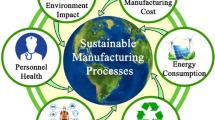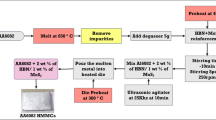Abstract
Aluminum-based metal matrix composites (MMCs) offer a high strength-to-weight ratio with excellent abrasion resistance, finding vast applications in aerospace industries. However, machining these materials is difficult due to the high hardness and wear resistance resulting in a shortened tool life. In this context, Al 7075 hybrid MMC was fabricated with reinforcing elements of TiO2 and Gr (graphite) particles. Furthermore, the machinability of newly fabricated HMMC was investigated under dry, MQL with vegetable oil, cryogenic CO2, and hybrid (MQL + CO2) cutting environments. As per the originality of this work, no studies compared the machinability of Al 7075 HMMC under selected cutting environments. With the reinforcement in Al alloy, the higher cutting forces and deteriorated surface finish were observed with dry milling. The abrasion wear mechanism will dominate under all cutting environments with various feeds and speeds. The combination of MQL + CO2 cutting environments was found to be more effective in terms of cutting forces, with a reduction of 39 to 28% compared to other selected cutting environments. The surface roughness was reduced by 18%, 15%, and 13% with favorable chip generation under MQL + CO2 than that of dry, MQL, and CO2 cooling modes. Additionally, MQL + CO2 showed enhanced tool life with a significant reduction in tool wear.











Similar content being viewed by others
Data availability
Not applicable.
Code availability
Not applicable.
References
Rajeswari B, Amirthagadeswaran K (2018) Study of machinability and parametric optimization of end milling on aluminium hybrid composites using multi-objective genetic algorithm. J Braz Soc Mech Sci Eng 40:1–15
Jawalkar C, Kant S, Panwar N, Sharma MD, Pali HS (2020) Effect of particle size variation of bagasse ash on mechanical properties of aluminium hybrid metal matrix composites. Materials Today: Proceedings 21:2024–2029
Wang H, Zhang H, Cui Z, Chen Z, Chen D, Wang H (2019) Investigation on the high-temperature ductility and fracture mechanisms of an in-situ particle reinforced Al matrix composite 7075Al/TiB2. Mater Sci Eng, A 764:138263
Geng R, Qiu F, Jiang QC (2018) Reinforcement in Al matrix composites: a review of strengthening behavior of nano-sized particles. Adv Eng Mater 20(9):1701089
Li Y, Qiao G, Jin Z (2002) Machinable Al2O3/BN composite ceramics with strong mechanical properties. Mater Res Bull 37(8):1401–1409
Dhanalakshmi S, Mohanasundararaju N, Venkatakrishnan P (2014) Preparation and mechanical characterization of stir cast hybrid Al7075-Al2O3-B4C metal matrix composites. Appl Mech Mater 592:705–710
Liao Z, Abdelhafeez A, Li H, Yang Y, Diaz OG, Axinte D (2019) State-of-the-art of surface integrity in machining of metal matrix composites. Int J Mach Tools Manuf 143:63–91
Kannan C, Ramanujam R, Balan A (2018) Machinability studies on Al 7075/BN/Al2O3 squeeze cast hybrid nanocomposite under different machining environments. Mater Manuf Processes 33(5):587–595
Xiuli F, Yongzhi P, Yi W, Xing A (2010) Research on predictive model surface roughness in high speed milling for aluminum alloy 7050–T7451. International Conference on Computing, Control and Industrial Engineering, IEEE 2:186–189
Gupta MK, Korkmaz ME, Yılmaz H, Şirin Ş, Ross NS, Jamil M, Królczyk GM, Sharma VS (2023) Real-time monitoring and measurement of energy characteristics in sustainable machining of titanium alloys. Measurement 224:113937
Ross NS, Manasea Selvin BJA, Nagarajan S, Mashinini PM, Dharmalingam SK, Savio AP, Gupta MK, Korkmaz ME (2023) Novel use of cryogenic cooling conditions in improving the machining performance of Al 8011/nano-SiC composites. Int J Adv Manuf Technol 129(3):1703–1715
Sivalingam V, Zhou Q, Manickajothi G, Ross NS, Sun J, Gupta MK, Korkmaz ME, Nagamalai T (2023) Understanding the machining characteristics of Al6082 hybrid metal matrix composites milled under cryogenic cooling conditions. Int J Adv Manuf Technol 129(7):3387–3402
Danish M, Gupta MK, Rubaiee S, Ahmed A, Korkmaz ME (2021) Influence of hybrid Cryo-MQL lubri-cooling strategy on the machining and tribological characteristics of Inconel 718. Tribol Int 163:107178
Behera BC, Alemayehu H, Ghosh S, Rao PV (2017) A comparative study of recent lubri-coolant strategies for turning of Ni-based superalloy. J Manuf Process 30:541–552
Pereira O, Urbikain G, Rodríguez A, Fernández-Valdivielso A, Calleja A, Ayesta I, de Lacalle LL (2017) Internal cryolubrication approach for Inconel 718 milling. Procedia Manuf 13:89–93
Iturbe A, Hormaetxe E, Garay A, Arrazola P (2016) Surface integrity analysis when machining Inconel 718 with conventional and cryogenic cooling. Procedia Cirp 45:67–70
Ostrowicki N, Kaim A, Gross D, Hanenkamp N (2021) Effect of various cooling lubricant strategies on turning Inconel 718 with different cutting materials. Procedia CIRP 101:350–353
Bagherzadeh A, Koc B, Budak E, Isik M (2022) High-speed machining of additively manufactured Inconel 718 using hybrid cryogenic cooling methods. Virtual Phys Prototyp 17(3):419–436
Alemayehu H, Ghosh S, Rao P (2020) Evaluation of cutting force and surface roughness of inconel 718 using a hybrid ultrasonic vibration-assisted turning and minimum quantity lubrication (MQL). In Advances in Unconventional Machining and Composites: Proceedings of AIMTDR 2018. Springer Singapore, pp 325–333
Şap S, Usca ÜA, Uzun M, Kuntoğlu M, Salur E (2022) Performance evaluation of AlTiN coated carbide tools during machining of ceramic reinforced Cu-based hybrid composites under cryogenic, pure-minimum quantity lubrication and dry regimes. J Compos Mater 56(22):3401–3421
Korkmaz ME, Gupta M, Ross NS, Sivalingam V (2023) Implementation of green cooling/lubrication strategies in metal cutting industries: a state of the art towards sustainable future and challenges. Sustain Mater Technol, p e00641
Muthuraman V, Arunkumar S (2017) Experimental evaluation of machining parameters in machining of 7075 aluminium alloy with cryogenic liquid nitrogen coolant. InIOP Conference Series: Materials Science and Engineering, IOP Publishing 183(2):012012
Jebaraj M, Pradeep Kumar M (2019) Effect of cryogenic CO2 and LN2 coolants in milling of aluminum alloy. Mater Manuf Processes 34(5):511–520
Zhang X, Mu H, Huang X, Fu Z, Zhu D, Ding H (2015) Cryogenic milling of aluminium-lithium alloys: thermo-mechanical modelling towards fine-tuning of part surface residual stress. Procedia Cirp 31:160–165
Ross KNS, Manimaran G (2020) Machining investigation of Nimonic-80A superalloy under cryogenic CO2 as coolant using PVD-TiAlN/TiN coated tool at 45 nozzle angle. Arab J Sci Eng 45(11):9267–9281
Nimel Sworna Ross K, Ganesh M (2019) Performance analysis of machining Ti–6Al–4V under cryogenic CO 2 using PVD-TiN coated tool. J Fail Anal Prev 19:821–831
Karabulut Ş, Çinici H, Karakoç H (2016) Experimental investigation and optimization of cutting force and tool wear in milling Al7075 and open-cell SiC foam composite. Arab J Sci Eng 41:1797–1812
Sen B, Mia M, Krolczyk GM, Mandal UK, Mondal SP (2021) Eco-friendly cutting fluids in minimum quantity lubrication assisted machining: a review on the perception of sustainable manufacturing. Int J Precis Eng Manuf-Green Tech 8:249–280
Maruda RW, Krolczyk GM, Wojciechowski S, Powalka B, Klos S, Szczotkarz N, Matuszak M, Khanna N (2020) Evaluation of turning with different cooling-lubricating techniques in terms of surface integrity and tribologic properties. Tribol Int 148:106334
Krolczyk GM, Maruda RW, Krolczyk JB, Wojciechowski S, Mia M, Nieslony P, Budzik G (2019) Ecological trends in machining as a key factor in sustainable production—a review. J Clean Prod 218:601–615
Chakravarthy VK, Rajmohan T, Vijayan D, Palanikumar K (2021) Sustainable drilling of nano SiC reinforced Al matrix composites using MQL and cryogenic cooling for achieving the better surface integrity. Silicon 14(4):1787–805
Ramkumar T, Selvakumar M, Mohanraj M, Chandrasekar P (2019) Experimental investigation and analysis of drilling parameters of metal matrix (Ti/TiB) composites. J Braz Soc Mech Sci Eng 41:1–12
Vignesh Kumar V, Raja K, Chandra Sekar V, Ramkumar T (2019) Thrust force evaluation and microstructure characterization of hybrid composites (Al7075/B 4 C/BN) processed by conventional casting technique. J Braz Soc Mech Sci Eng 41:1–14
Yıldırım ÇV, Kıvak T, Sarıkaya M, Şirin Ş (2020) Evaluation of tool wear, surface roughness/topography and chip morphology when machining of Ni-based alloy 625 under MQL, cryogenic cooling and CryoMQL. J Market Res 9(2):2079–2092
Wojciechowski S, Krajewska-Śpiewak J, Maruda R, Krolczyk G, Nieslony P, Wieczorowski M, Gawlik J (2023) Study on ploughing phenomena in tool flank face–workpiece interface including tool wear effect during ball-end milling. Tribol Int 181:108313
Szczotkarz N, Mrugalski R, Maruda RW, Królczyk GM, Legutko S, Leksycki K, Dębowski D, Pruncu CI (2021) Cutting tool wear in turning 316L stainless steel in the conditions of minimized lubrication. Tribol Int 156:106813
Sougavabar MA, Niknam SA, Davoodi B (2023) Experimental characterization of tool wear morphology in milling of Al520-MMC reinforced with SiC particles and additive elements Bi and Sn. J Market Res 24:571–585
Author information
Authors and Affiliations
Corresponding authors
Ethics declarations
Ethics approval
Not applicable.
Consent to participate
Not applicable.
Consent for publication
Not applicable.
Conflict of interest
The authors declare no competing interests.
Additional information
Publisher's Note
Springer Nature remains neutral with regard to jurisdictional claims in published maps and institutional affiliations.
Rights and permissions
Springer Nature or its licensor (e.g. a society or other partner) holds exclusive rights to this article under a publishing agreement with the author(s) or other rightsholder(s); author self-archiving of the accepted manuscript version of this article is solely governed by the terms of such publishing agreement and applicable law.
About this article
Cite this article
Sivalingam, V., Liu, H., Tiwari, S. et al. Effect of reinforced particles on the machinability of Al alloy under MQL, cryogenic, and hybrid lubrication. Int J Adv Manuf Technol (2024). https://doi.org/10.1007/s00170-024-13534-7
Received:
Accepted:
Published:
DOI: https://doi.org/10.1007/s00170-024-13534-7




